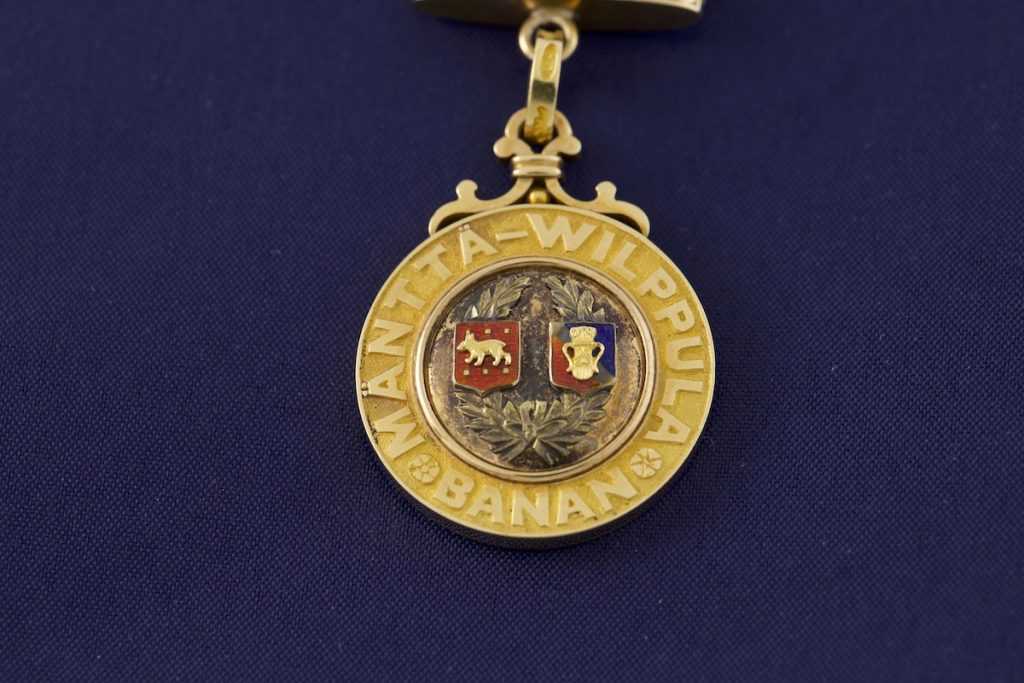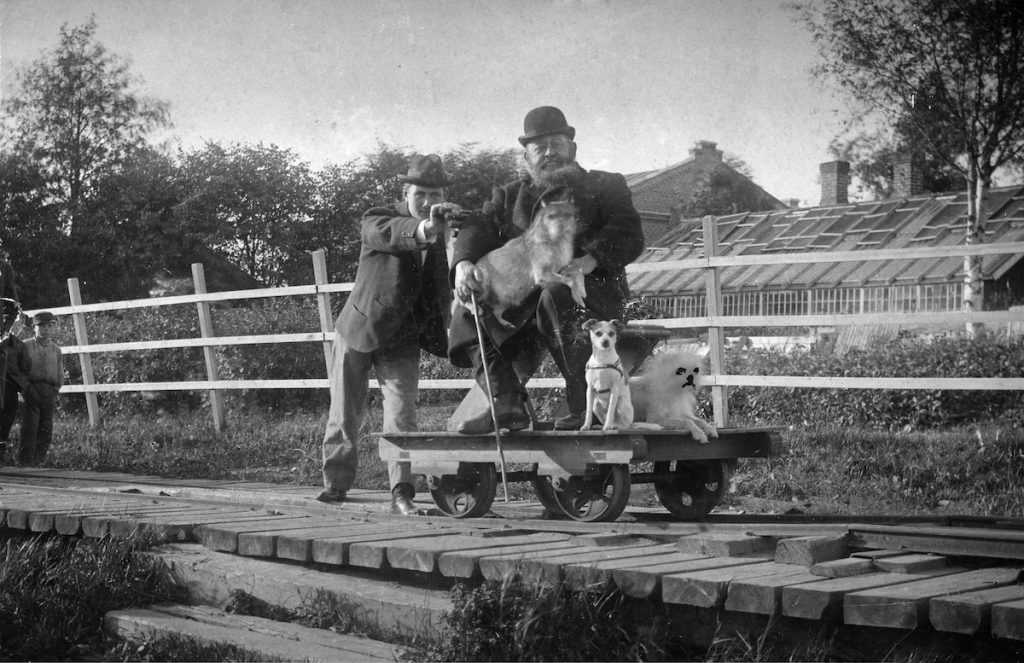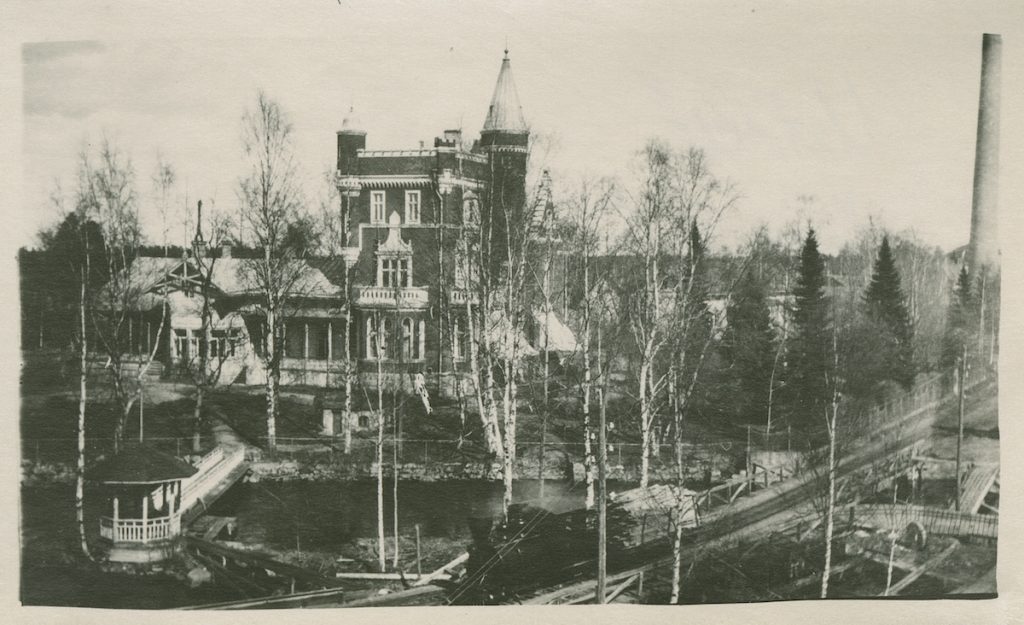Jeton of Mänttä Railway
NOVEMBER 2022
In Finland, Mänttä–Wilppula Railway (MWR) was the first narrow gauge railway to open public transport. Serlachius Museums’ collections comprise two railway jetons which were made to commemorate the opening of the railway line.
As mentioned, Mänttä’s railway is now ready to be used. As rolling stock on the railway is one locomotive, one so to speak passenger car for second and third classes and 40 freight cars. Ordinary freight traffic on this railway from Mänttä mills to Vilppula started yesterday; passenger traffic will begin only when the Senate has time to approve the ticket rates. (Newspaper Tampereen Sanomat on 9 November 1897)
Railway line between Tampere and Vaasa had enabled train connection to Vilppula in 1883. Mill owner G. A. Serlachius had had a significant impact for the fact that the railway line runs on the eastern side of Näsijärvi Lake. Soon discussions were opened to build a railway track also to Jyväskylä direction. Serlachius’ suggestion that it would run through Vilppula, Mänttä and Jämsä gained no support. So, Serlachius started to make plans for building a privately owned railway from Vilppula to Mänttä. The project was backed in 1894 by the Finnish Parliament’s grant of two Million Finn Marks for private railway lines.
Newspaper Tampereen Sanomat reported that on 22 Janury 1897 the Senate gave permission to build the narrow-gauge railway. Track width on Mänttä railway was 600 mm. Costs for setting up a narrow-gauge track and for its equipment were about one third lower than for normal gauge railway. In industrial sites, narrow track width allowed steep gradients in confined storage areas. The first passenger train ran on Mänttä Track on 16 October 1897 and the first freight train on 8 November 1897.
Mänttä railway line was used for transporting goods and passengers. It was announced in year 1900 that three trains ran between Mänttä and Vilppula. In addition, “if needed, extra church trains would be dispatched on Sundays, of which would be notified beforehand.” There were three stops: Vilppula, Koskela and Mänttä.
For the distance between Mänttä and Koskela, a longer time span had been reserved in the timetable. The stretch passed through the factory site, where the speed had to be reduced. The area contained also Serlachius family’s castle-home and the office of the mill. Timetable allowed stops on the stretch. A report in the personnel magazine ‘Mill and Us’ recalled: “And if everything went so wrong that one should miss the train, it was possible to catch it up by running before Koskela stop, even for those who had not had any special practice in running.
Narrow-gauge railway open for public transport had the same transport obligations and responsibilities as the state-owned railways. Detailed instructions had been issued in the charter and operating rules. The printed traffic rule of Wilppula–Mänttä Railway contains instructions on transporting passengers and baggage. The instruction book does not, however, mention jetons.
Railway jeton was a medal that was made in honour of completion of the railway track. Traditionally it warranted a free travel on the railway. On state owned railway, only few persons were granted a jeton, such as the highest officials. Jeton was normally carried in watch-chains or buttonhole. The book Kapeat kiskot (Narrow track) states that among the private narrow-gauge railways in Finland only three are known to have jetons: Hyvinkää–Pyhäjärvi railway, Jokioinen’s railway and Mänttä’s railway. Originally of Russian heritage, the jetons had their golden era on Finnish railway in the turn of 19th and 20th centuries.
Various embossed patterns and enamelled details give multidimensionality for Mänttä-Vilppula railway jeton. Based on the labels, the jetons comprised in Serlachius Museums’ collections have been manufactured by goldsmith shop R. Mellin in years 1899 and 1901. The renowned goldsmith shop was established by master goldsmith Roland Mellin (1803–1871) who had moved to Helsinki from the Swedish town of Nyköping.Mänttä’s narrow-gauge railway gradually fell into disuse when the railway built by Finnish Railway was opened to traffic in 1929. On the site of Mänttä mills, the narrow-gauge track was in operation until 1955.
Katri Tolonen
Curator
Sources:
Kapeat kiskot [Narrow Gauge Track]. Suomen yleiselle liikenteelle avatut yksityiset kapearaiteiset rautatiet. Toim. Matti Bergström, Erkki Einola ja Olavi Kilpiö. Jokioisten Museorautatie, Rautatiemuseo ja Veturimuseo, 1993.
Kultaseppämestarit, Roland & Otto Roland Mellin. Toim. Lehto, Marja-Liisa & Vainio, Sinikka. Helsingin kaupunginmuseo, 1991.
Liikenneohjesääntö ja liikennetaksa Wilppulan – Mäntän rautatietä warten. Tampereen Kiwipaino Osakeyhtiö, 1899.
Personnel magazine Tehdas ja Me [The Mill and us] 1/1955.
Newspaper Tampereen Sanomat 16.3.1897, 17.10.1897 ja 9.11.1897.
Hedman, Tarja & Sivonen, Pauli. Museo jalkautuu kaupunkiin. Gösta Serlachiuksen taidesäätiö, 2004.




